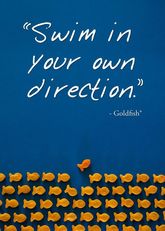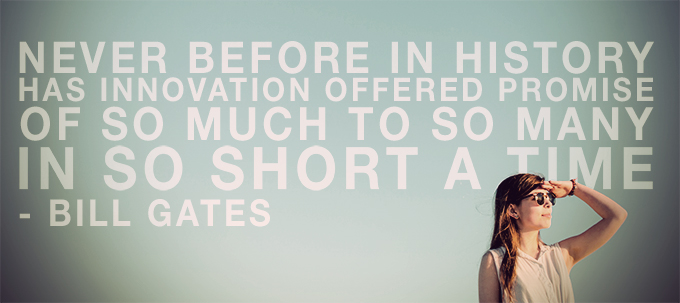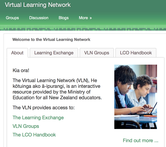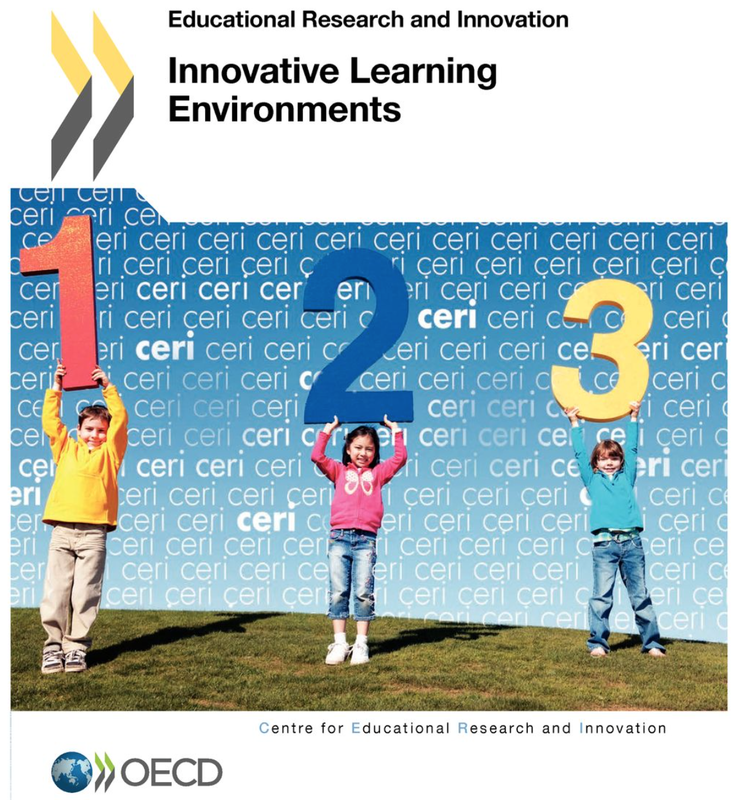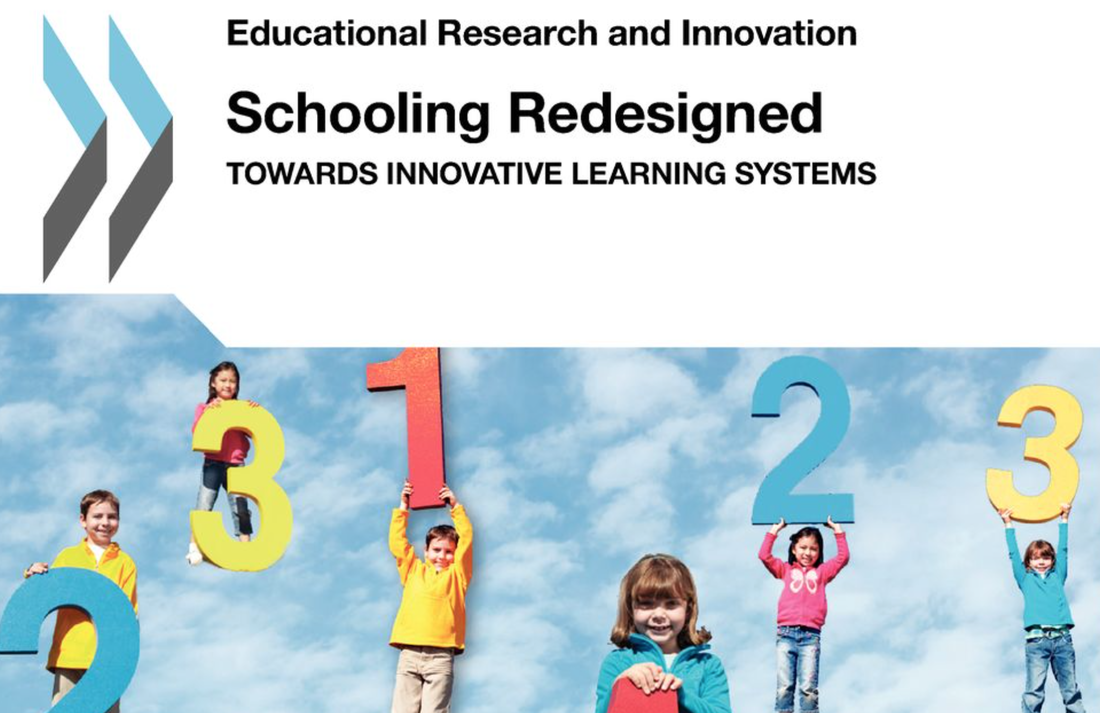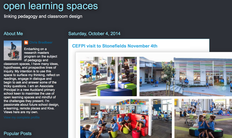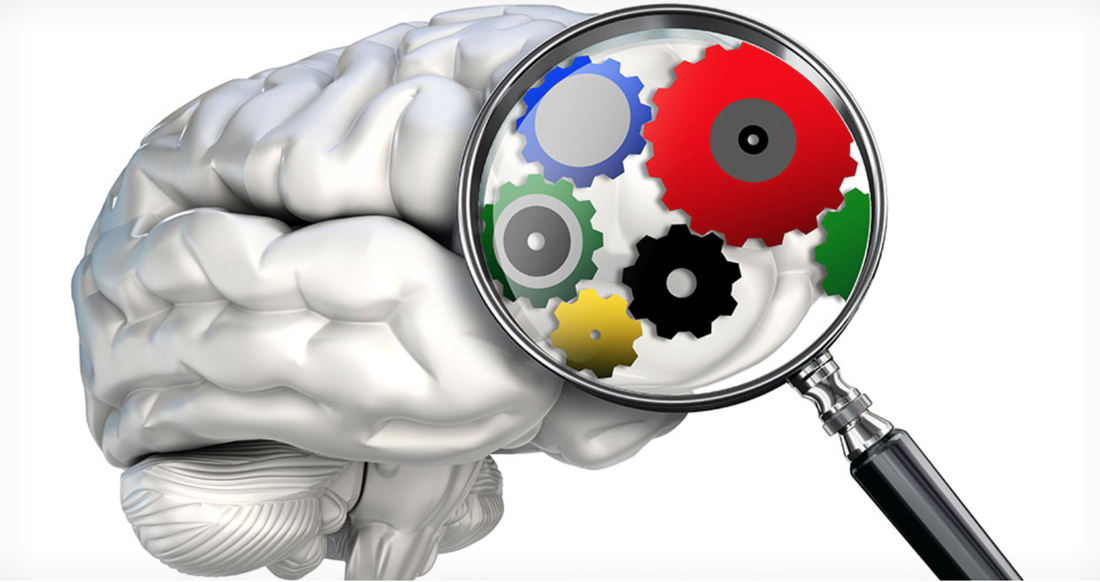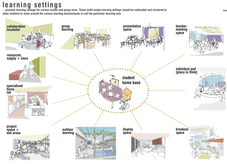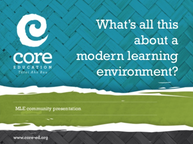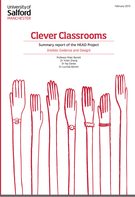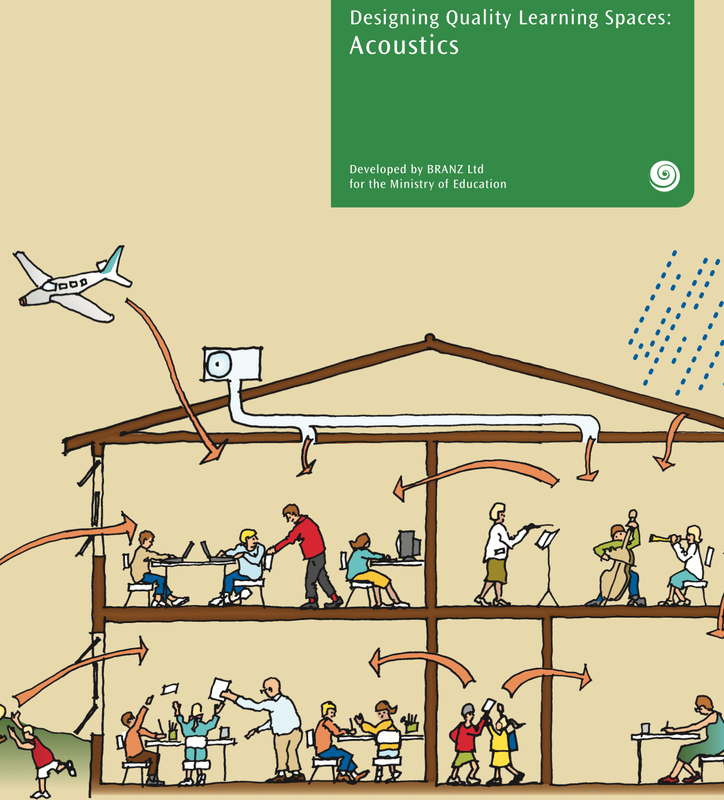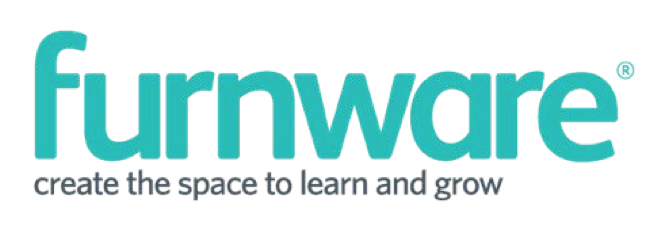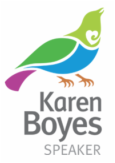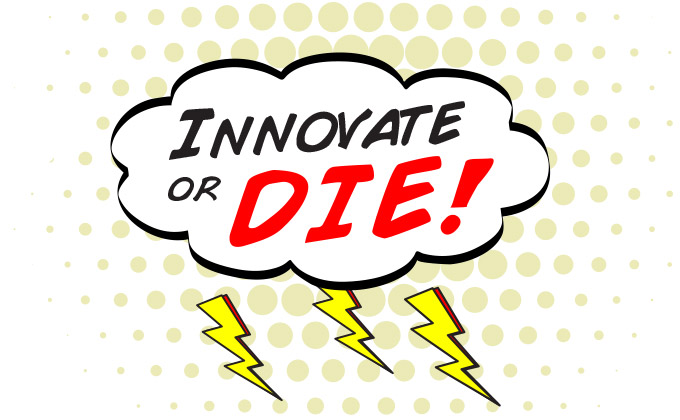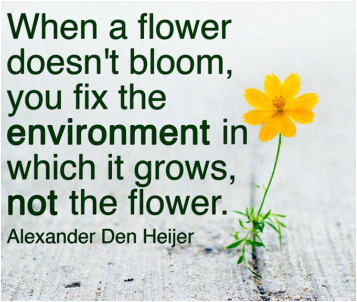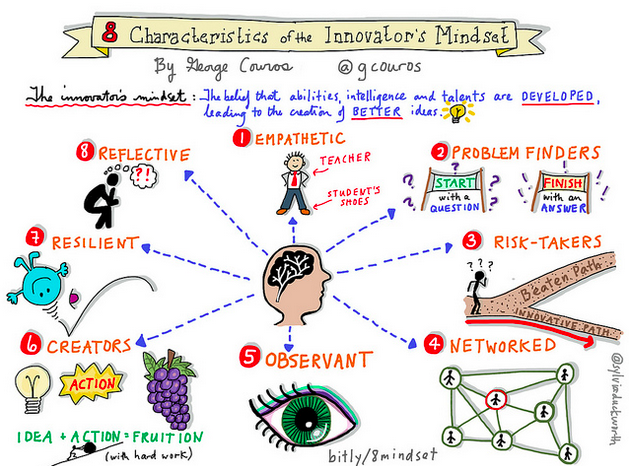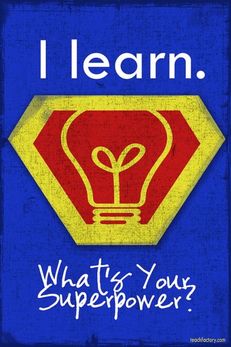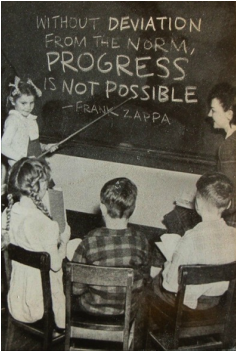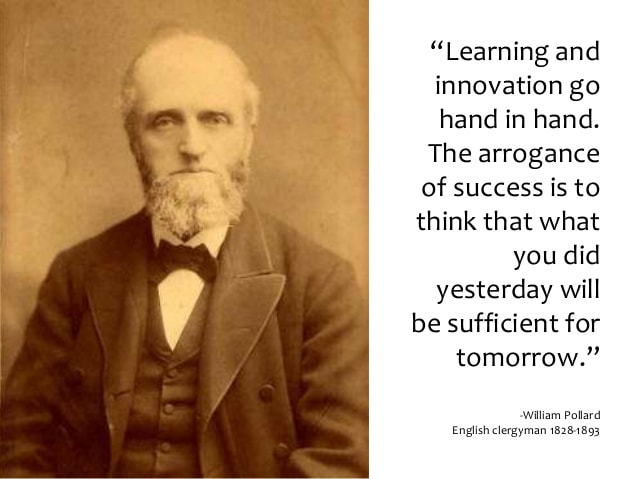Resources & Research - Innovative Learning Environments
Useful Readings and Resources
A huge range of resources that contain information about the physical design of ILEs, research about the effect of the physical environment, and also the teaching and learning approaches within an ILE.
|
The Innovative Learning Environments and Teacher Change (ILETC) project is an Australian Research Council (ARC) Linkage Project funded for 4 years from 2016-2019. It brings together the expertise of leading researchers in education and learning environments and partner organisations in education and learning environment design and technology.
|
|
ILE Govt site.
Interesting that is now called ILEs (Innovative Learning Environments, due to "growing discomfort with the term MLE"). Is also to bring it more closely in line with what the OECD uses as a term. |
|
Grow Waitaha is a programme that supports schools through the process of change happening in Canterbury
Building new learning environments means developing new ways of working in those environments; Grow Waitaha is supporting schools through this process of change. The goal is to assist schools to achieve pedagogical change in a meaningful and manageable way, with a network of support. This site contains links to a wide range of valuable resources to support the development of ILE and collaboration. |
|
Virtual Learning Network: Modern Learning Environment Group
A great way to share ideas with colleagues with a wide range of threads related to MLE development |
|
TKI: enabling e-Learning - ILE
A great site with links to a wide variety of other resources and readings |
|
OECD Report: Innovative Learning Environments
This report looks at innovative learning environment from around the world, as part of the OECD's ILE project. The key elements are termed the "pedagogical core", composed of 4 elements: learners, educators, content and resources. The report also discusses 7 key ILE principles: make learning and engagement central, ensure that learning is social and often collaborative, be highly attuned to learner motivations and emotions, be acutely sensitive to individual differences, be demanding for each learner but without excessive overload, use assessments with learning aims, with strong emphasis on formative feedback, promote horizontal connectedness across activities and subjects, in and out of school |
|
Schooling Redesigned - Towards Innovative Learning Systems OECD
What does redesigning schools and schooling through innovation mean in practice? How might it be brought about? These questions have inspired an influential international reflection on “Innovative Learning Environments” (ILE) led by the OECD. |

Modern Learning Environments: Are you ready?
An interesting read about Modern Learning Environments, including the role of the library.
Snippets:
"The focus of innovative learning spaces is never about the building. It's what the building enables users to do."
"If we believe that everyone brings different prior knowledge to a topic and no two people learn the same thing in the same way at the same speed, then it doesn’t make sense to have a classroom set up with everyone facing the front doing the same thing at the same time."
An interesting read about Modern Learning Environments, including the role of the library.
Snippets:
"The focus of innovative learning spaces is never about the building. It's what the building enables users to do."
"If we believe that everyone brings different prior knowledge to a topic and no two people learn the same thing in the same way at the same speed, then it doesn’t make sense to have a classroom set up with everyone facing the front doing the same thing at the same time."
| modern_learning_environments_-_are_you_ready | |
| File Size: | 2980 kb |
| File Type: | modern learning environments - are you ready |
|
The Misunderstood Ingredient in Modern Learning Environments
A great piece from Longworth Education |
|
Making best use of Learning Environments - Mark Osborne
Great short read, which includes UDL and Tataiako being weaved into ILE. |
|
ILE Database across NZ
A database to help teachers / school leaders connect and form relationships with others to share excellence / experiences / wisdom in this brave new world of ILE. |

Core Education have a huge range of excellent information and support material. A selection is below:
http://blog.core-ed.org/blog/category/modern-learning-environments http://www.core-ed.org/professional-learning/mle-matrix |
|
| ||||||||||||

EDtalks
A superb site (a Core Education initiative) containing interviews, discussions and presentations from innovative leaders and educators. edtalks modern learning environments |
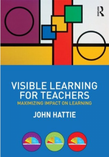
John Hattie - Visible Learning for Teachers
My own thought is that the crux of Innovative Learning Environments are that they provide our teachers greater opportunities to use the pedagogies that really make a difference.
Hattie takes the guesswork out of what these practices are and what really works. In addition to learning what students know, teachers also need to learn how their students learn as well (this is enhanced within collaborative teams)
Snippet: "One of the great takeaways from Visible Learning is that there is great power from teachers learning from each other. When teachers begin to collaborate and develop common understandings...then all begin to move in the right direction."
My own thought is that the crux of Innovative Learning Environments are that they provide our teachers greater opportunities to use the pedagogies that really make a difference.
Hattie takes the guesswork out of what these practices are and what really works. In addition to learning what students know, teachers also need to learn how their students learn as well (this is enhanced within collaborative teams)
Snippet: "One of the great takeaways from Visible Learning is that there is great power from teachers learning from each other. When teachers begin to collaborate and develop common understandings...then all begin to move in the right direction."
|
| ||||||||||||
|
Chris Bradbeer - Open Learning Spaces Blog
Chris is a current DP at Stonefields School, Auckland and a good thinker. Be sure to hunt through some of the older posts for "hidden gems!" http://www.openlearningspaces.blogspot.co.nz |
|
Learning Spaces - Educause - Diana Oblinger Editor
A brilliant read, and free pdf downloads are available here via the link. Snippet: A Space, whether physical or virtual, can have a significant impact on learning. Learning Spaces focuses on how learner expectations influence such spaces, the principles and activities that facilitate learning, and the role of technology from the perspective of those who create learning environments. This e-book represents an ongoing exploration as we bring together space, technology, and pedagogy to ensure learner success. This site also offers case studies illustrating those principles, including links to examples of innovative learning spaces. The entire collection is complete and available for printing as individual chapters or the entire book. |
|
Global Digital Citizenship Foundation: The Active Learning Classroom: 8 Essential Elements
|
|
Linking Pedagogy and Space by Dr. Kenn Fisher
A useful document that starts off by looking at the curriculum context and developing teaching and learning principles, before linking these principles to place and a range of learning settings. It also includes a range of case studies.
| |||||||
|
Derek Wenmouth Blog: Does a MLE suit all learners?
|
|
Slideshare Presentations by Derek Wenmouth
Derek is an outstanding thinker and speaker. 2 great presentations here, pitched at informing parents/community regarding changes in education and MLEs |
|
|
Clever Classrooms
A very interesting report about the impact of the physical learning environment. "Clear evidence has been found that well-designed primary schools boost children’s academic performance in reading, writing and maths. Differences in the physical characteristics of classrooms explain 16% of the variation in learning progress over a year for the 3766 pupils included in the study." |
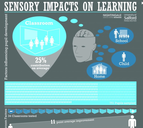
University of Salford Study on the Effects of the Built Environment
In a pilot study by the University of Salford, it was found that the classroom environment can affect a child’s academic progress over a year by as much as 25%.
The study took two lines of enquiry. The first was to collect data from 751 pupils, such as their age, gender and performance level in maths, reading and writing at the start and end of an academic year.
The second evaluated the holistic classroom environment, taking into account different design parameters such as classroom orientation, natural light and noise, temperature and air quality. Other issues such as flexibility of space, storage facilities and organisation, as well as use of colour were evaluated.
Current findings suggest that placing an average pupil in the least effective, rather than the most effective classroom environment could affect their learning progress by as much as the average improvement across one year.
In a pilot study by the University of Salford, it was found that the classroom environment can affect a child’s academic progress over a year by as much as 25%.
The study took two lines of enquiry. The first was to collect data from 751 pupils, such as their age, gender and performance level in maths, reading and writing at the start and end of an academic year.
The second evaluated the holistic classroom environment, taking into account different design parameters such as classroom orientation, natural light and noise, temperature and air quality. Other issues such as flexibility of space, storage facilities and organisation, as well as use of colour were evaluated.
Current findings suggest that placing an average pupil in the least effective, rather than the most effective classroom environment could affect their learning progress by as much as the average improvement across one year.
|
TKI Site - Enabling eLearning - Modern Learning Environments
A massive resource bank of school stories, movies and advice |
|
Why Change - Think Beyond by Dr. Cheryl Doig
A great site with lots of good thinking as well as resource links why change?, collaboration, teaching, physical environment, student involvement, and trends. |
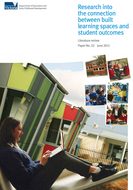
Research into the Connection Between Built Learning Spaces and Student Outcomes
This literature review asks the question: To what extent does the literature show connections between learning spaces and student learning outcomes in schools?
The conceptual framework for the review includes the following phases:
This literature review asks the question: To what extent does the literature show connections between learning spaces and student learning outcomes in schools?
The conceptual framework for the review includes the following phases:
- Design
- Implementation and Transition
- Consolidation
- Sustainability/Re-evaluation
| connection_between_built_learning_spaces_and_student_outcomes.pdf | |
| File Size: | 2118 kb |
| File Type: | |
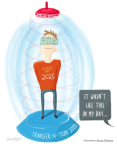
Agile Learning Spaces a user manual for teachers and students by Prof. Stephen Heppell Juliette Heppell Melissa Heppell
All round the world new agile spaces, with zones and nooks and new approaches to seating and organisation are appearing because they make better spaces and places for creating engaging learning. But how to use those spaces, how to work together as teachers, and students, in those spaces - and how to avoid gainsayers trying to drag us backwards and losing all the advantages these spaces can offer? A user manual is needed. This document has been written for the new integrated science learning spaces at Wesley College in Western Australia’s Perth, but it should help others everywhere too... |
| ||||||
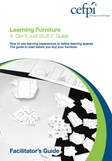
Learning Furniture - A 'Don't Just Stuff It' Guide
CEFPI Guide on how to use learning experiences to define learning spaces. The guide also contains some useful scale models of furniture for any prototyping.
Snippet: One of the ways in which the built environment influences how teachers teach and how students learn is by communicating pedagogical intent. Components of the built environment, including buildings, interior design elements and loose furniture, provide environmental cues to teachers and students about how they should act.
The selection and arrangement of furniture should be carefully considered to ensure that it actively supports the style of teaching and learning that is desired in a school.
CEFPI Guide on how to use learning experiences to define learning spaces. The guide also contains some useful scale models of furniture for any prototyping.
Snippet: One of the ways in which the built environment influences how teachers teach and how students learn is by communicating pedagogical intent. Components of the built environment, including buildings, interior design elements and loose furniture, provide environmental cues to teachers and students about how they should act.
The selection and arrangement of furniture should be carefully considered to ensure that it actively supports the style of teaching and learning that is desired in a school.
| learning_furniture.pdf | |
| File Size: | 2001 kb |
| File Type: | |
|
What Impact Does a MLE have on Pedagogical Practice and Student Learning Experience - Ngaire Shepherd-Wills
Sabbatical Report & Blog An interesting read containing student and teacher voice related to the experiences of transitioning from a traditional classroom to an MLE. Also check out Ngaire's website, which has some great links in the blog section (under archives and tags) |
| |||||||
|
Learning Spaces by Wayne Barry - Slideshare Presentation
learning spaces "should be able to motivate learners and promote learning as an activity, support collaborative as well as formal practice, provide a personalised and inclusive environment, and be flexible in the face of changing needs..." - so what do we really know about them? |
The Move to Modern Learning Environments in New Zealand Secondary Schools: Step Forward or Smokescreen? Jo-Anne Bisset Thesis
Abstract: To prepare 21st century learners for what has become known as the ‘knowledge age’ the New Zealand government is recognising the need to provide the flexibility of modern learning environments (MLEs), rather than investing in older school buildings (Ministry of Education, 2014b). In conjunction with the tangible elements of buildings, furniture and technology, there is also a major shift in educational practices and pedagogy integral to MLEs (Ministry of Education, 2007). Despite this major change to New Zealand schools, there is a paucity of literature into the perceived benefits, or otherwise, of the introduction of MLEs to secondary schools in the New Zealand context. This study examines the shift towards MLEs in three secondary schools and the changes in pedagogy that are occurring as a result of this change.
Abstract: To prepare 21st century learners for what has become known as the ‘knowledge age’ the New Zealand government is recognising the need to provide the flexibility of modern learning environments (MLEs), rather than investing in older school buildings (Ministry of Education, 2014b). In conjunction with the tangible elements of buildings, furniture and technology, there is also a major shift in educational practices and pedagogy integral to MLEs (Ministry of Education, 2007). Despite this major change to New Zealand schools, there is a paucity of literature into the perceived benefits, or otherwise, of the introduction of MLEs to secondary schools in the New Zealand context. This study examines the shift towards MLEs in three secondary schools and the changes in pedagogy that are occurring as a result of this change.
| jo-anne_bisset_thesis.pdf | |
| File Size: | 1300 kb |
| File Type: | |
|
Designing Quality Learning Spaces: Acoustics - BRANZ Ltd Report for the MOE
A frequently asked question about ILE's is "Are they noisy?". My answer is usually "yes" and "no". "Yes" in the sense that obviously there are more learners in the environment now than a single cell class. It is important too that we recognise that an effective class isn't necessarily sitting in silence like the days of old, where these classes would be said to be "humming" or "highly effective" (where in actuality the work was probably too easy for at least a 1/3 and too hard for at least a 1/3). We actively encourage students to be discussing, working with a buddy and collaborating, therefore the classroom noise will also be higher. Noise does not necessarily equate to being off task nor not being able to concentrate. "No" in the sense that classroom designs now are engineered for sound. Even older existing block refurbs take into account the noise reductions from floor/wall coverings, joinery/windows, heating, insulation between rooms, breakout spaces etc | ||||||
The Effect of the Physical Learning Environment on Teaching and Learning
This reading explores the effect of the physical learning environment on student achievement and teachers' work.
Snippets:
Studies about student academic achievement and building condition conclude that the quality of the physical environment significantly affects student achievement. 'There is sufficient research to state without equivocation that the building in which students spends a good deal of their time learning does in fact influence how well they learn' (Earthman, G 2004:18).
Other research has acknowledged that 'student achievement lags in shabby school buildings'
In one study the significant improvements in the learning environment were attributed to the better attitudes to teaching and learning the improvements in the physical environment created amongst all users (Berry in Higgins et al 2005:14).
Siegel has found there was a direct relationship between architecture and the collaboration of teachers. Consideration of the spaces where teachers meet and collaborate is just as important as the design of the classroom (McGregor, J 2004:4).
This reading explores the effect of the physical learning environment on student achievement and teachers' work.
Snippets:
Studies about student academic achievement and building condition conclude that the quality of the physical environment significantly affects student achievement. 'There is sufficient research to state without equivocation that the building in which students spends a good deal of their time learning does in fact influence how well they learn' (Earthman, G 2004:18).
Other research has acknowledged that 'student achievement lags in shabby school buildings'
In one study the significant improvements in the learning environment were attributed to the better attitudes to teaching and learning the improvements in the physical environment created amongst all users (Berry in Higgins et al 2005:14).
Siegel has found there was a direct relationship between architecture and the collaboration of teachers. Consideration of the spaces where teachers meet and collaborate is just as important as the design of the classroom (McGregor, J 2004:4).
| the-effect-of-the-physical-learning-environment-on-teaching-and-learning.pdf | |
| File Size: | 83 kb |
| File Type: | |
|
|
A Comfortable Truth: Well-Planned Classrooms Make a Difference
Snippets: If we were to assemble a list of adjectives to describe school, comfortable would not make the cut. Many of the places where vital teaching occurs, if not designed expressly for physical torment, are infamously uninviting. Even after almost a century, John Dewey's 1915 exhortation that "nature has not adapted the young animal to the narrow desk, the crowded curriculum, the silent absorption of complicated facts" remains largely unheard. What is the rationale for justifying the lack of creature comfort in today's schools? Nothing more defensible than the old dodge "We've always done it that way." But schools wear out and are renovated or replaced by new structures. And architects know far more about how people live and work than they once did. So the factory model is slowly relegated to history, like the dinosaur it is. Should schools be comfortable, and if so, why? Comfort is the new black. Everywhere except schools. |
|
Furnware MLE Presentation to Te Kowhai Staff
A furniture company that really understands school's vision for teaching and learning, and how they can contribute purposely. Check out the presentation below, and also the MLE Case Studies.
| |||||||||
|
Karen Boyes Blog: Modern Learning Environments – the underlying philosophy to success
A thoughtful piece in which Karen outlines five considerations that are vital to address for success in the MLE journey.
|
Technology-Rich Innovative Learning Environments by Jennifer Groff
There are several key drivers pushing technology as a key component for educational system change, and these serve as central reasons that educators and education stakeholders should consider the growing relevance and implications of technology and technology-based school innovations (OECD, 2010):
There are several key drivers pushing technology as a key component for educational system change, and these serve as central reasons that educators and education stakeholders should consider the growing relevance and implications of technology and technology-based school innovations (OECD, 2010):
- Technology can perform several key functions in the change process, including opening up new opportunities that improve teaching and learning--particularly with the affordance of customisation of learning to individual learner needs, which is highly supported by the learning sciences;
- The skills for an adult life include technological literacy, and people who do not acquire and master these competencies may suffer from a new form of the digital divide, which will impact their capacity to effectively operate and thrive in the new knowledge economy;
- Technology is an integral part to accessing the higher-order competencies often referred to as 21st Century Skills, which are also necessary to be productive in today‘s society.
| technology-rich_innovative_learning_environments_by_jennifer_groff.pdf | |
| File Size: | 514 kb |
| File Type: | |
EFFECTIVENESS, EFFICIENCY AND SUFFICIENCY: AN OECD FRAMEWORK FOR A PHYSICAL LEARNING ENVIRONMENTS MODULE
Drawing on the latest evidence-based research about how investments in the physical learning environment – that is “the physical spaces (including formal and informal spaces) in which learners, teachers, content, equipment and technologies interact” – can translate into improved cognitive and non-cognitive outcomes, the authors map the student-, school-, community- and system-level inputs, processes and outcomes, in addition to evaluating the feasibility of measuring learning and other outcomes relating to the physical learning environment.
Drawing on the latest evidence-based research about how investments in the physical learning environment – that is “the physical spaces (including formal and informal spaces) in which learners, teachers, content, equipment and technologies interact” – can translate into improved cognitive and non-cognitive outcomes, the authors map the student-, school-, community- and system-level inputs, processes and outcomes, in addition to evaluating the feasibility of measuring learning and other outcomes relating to the physical learning environment.
|
|
| ||||||||||||||||||
21st Century Learning Environments
Experts say 21st century learning must take place in contexts that “promote interaction and a sense of community [that] enable formal and informal learning.” Thus, this paper will address the relationship of physical spaces and technological systems to learning, but more importantly, it will also consider how those resources support the positive human relationships that matter most to learning. And while technology, space, time, culture, and policy will be discussed separately, it is important to remember that their power is cumulative.
Experts say 21st century learning must take place in contexts that “promote interaction and a sense of community [that] enable formal and informal learning.” Thus, this paper will address the relationship of physical spaces and technological systems to learning, but more importantly, it will also consider how those resources support the positive human relationships that matter most to learning. And while technology, space, time, culture, and policy will be discussed separately, it is important to remember that their power is cumulative.
| 21st_century_learning_environments.pdf | |
| File Size: | 330 kb |
| File Type: | |
The Impact of School Environments: A literature review produced for the Design Council
Steve Higgins, Elaine Hall, Kate Wall, Pam Woolner, Caroline McCaughey
Professor Stephen Heppell argued at the expert seminar held to inform this literature review that ‘whereas, traditionally, we have designed for productivity, processing large numbers of children through the effective use of buildings, designing a room for learning is very complex. No one knows how to prevent ‘learning-loss’ when you design a room “pedagogically”, whereas we know lots about designing for minimum heat loss’.
The overarching brief for the literature review contained the following questions:
Steve Higgins, Elaine Hall, Kate Wall, Pam Woolner, Caroline McCaughey
Professor Stephen Heppell argued at the expert seminar held to inform this literature review that ‘whereas, traditionally, we have designed for productivity, processing large numbers of children through the effective use of buildings, designing a room for learning is very complex. No one knows how to prevent ‘learning-loss’ when you design a room “pedagogically”, whereas we know lots about designing for minimum heat loss’.
The overarching brief for the literature review contained the following questions:
- – What makes a good school (physical) learning environment?
- – What impact do (physical) school learning environments have on student behaviour, motivation, learning and achievement?
- – Which components/elements of school learning environments make the most difference to pupil behaviour, motivation, learning and achievement, and why?
- – What evidence exists to indicate the relative balance between the physical environment and the emotional and cognitive environments on pupil behaviour, motivation, learning and achievement
| the_impact_of_school_environments.pdf | |
| File Size: | 459 kb |
| File Type: | |

Modern Learning for Secondary Schools: Crowd-sourced Google Doc
This shared presentation is for secondary schools (is also useful for primary schools too) who are interested in Modern Learning pedagogies, practices and examples of MLEs - new and refurbished spaces. The doc contains a huge number of links to further resources.
This shared presentation is for secondary schools (is also useful for primary schools too) who are interested in Modern Learning pedagogies, practices and examples of MLEs - new and refurbished spaces. The doc contains a huge number of links to further resources.
Primary School Leadership in Modern Learning Environments by Paul Cooper, Whitiora School - Sabbatical Report
A great read, containing a literature review and also Paul's own thoughts. Sections focus on leadership of MLEs, different types of team teaching/collaboration, support for developing teams, teacher empowerment and agency
A great read, containing a literature review and also Paul's own thoughts. Sections focus on leadership of MLEs, different types of team teaching/collaboration, support for developing teams, teacher empowerment and agency
| paul_cooper_sabbatical_report_2013_-_leadership_and_mles.pdf | |
| File Size: | 550 kb |
| File Type: | |
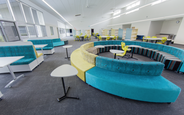
Leading Collaborative Classroom Design
It is a big pedagogic change from a traditional classroom from a space dominated by desks in rows to a space suiting 21st century learning that incorporates digital, mobile, independent and social collaboration (Beetham & Sharpe, 2013, Radcliffe et. al. 2008). This disruption can be exciting or distressing, depending on how much control people using the space feel they have in the situation. Before you start to make a change in the learning space, consider including those people who will be experiencing the change in the decision making process. How can you share control and increase their agency and the long term learning benefit? Quite often learning spaces are designed without teachers or students having any input. Instead of being empowering, these new learning spaces can cause teacher stress about how to teach in the new conditions, and confusion for students (Wilks, 2009). To make the most of the financial investment, the change leader also needs to consider the emotional and cognitive investment.
Web link and also full report below.
It is a big pedagogic change from a traditional classroom from a space dominated by desks in rows to a space suiting 21st century learning that incorporates digital, mobile, independent and social collaboration (Beetham & Sharpe, 2013, Radcliffe et. al. 2008). This disruption can be exciting or distressing, depending on how much control people using the space feel they have in the situation. Before you start to make a change in the learning space, consider including those people who will be experiencing the change in the decision making process. How can you share control and increase their agency and the long term learning benefit? Quite often learning spaces are designed without teachers or students having any input. Instead of being empowering, these new learning spaces can cause teacher stress about how to teach in the new conditions, and confusion for students (Wilks, 2009). To make the most of the financial investment, the change leader also needs to consider the emotional and cognitive investment.
Web link and also full report below.
| |||||||
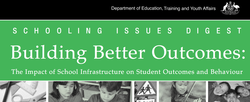
SCHOOLING ISSUES DIGEST: Building Better Outcomes: The Impact of School Infrastructure on Student Outcomes and Behaviour
This Digest reviews a range of research studies which examine the possible causal linkages between building design and student outcomes.
The research indicates that:
This Digest reviews a range of research studies which examine the possible causal linkages between building design and student outcomes.
The research indicates that:
- student academic achievement improves with improved building condition;
- individual factors, such as lighting levels, air quality and temperature and
acoustics, have an effect on student behaviour and outcomes, although there is limited quantitative evidence available on some of these factors.
| the_impact_of_school_infrastructure_on_student_outcomes_and_behaviour.pdf | |
| File Size: | 146 kb |
| File Type: | |
|
Environments for 21st Century Learning:
Ron Hoffart at TEDxWestVancouverED |
"What is an Innovative Learning Environment?"
25 OECD ILE project collaborators share their thoughts |
|
|
|

